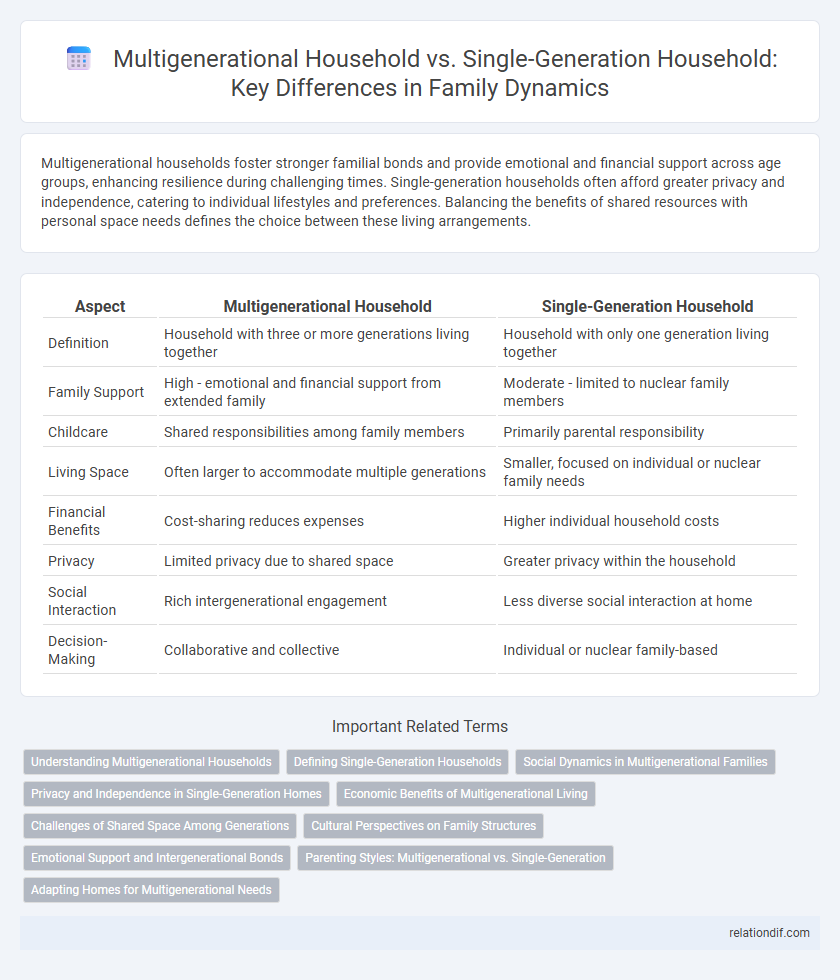Multigenerational households foster stronger familial bonds and provide emotional and financial support across age groups, enhancing resilience during challenging times. Single-generation households often afford greater privacy and independence, catering to individual lifestyles and preferences. Balancing the benefits of shared resources with personal space needs defines the choice between these living arrangements.
Table of Comparison
| Aspect | Multigenerational Household | Single-Generation Household |
|---|---|---|
| Definition | Household with three or more generations living together | Household with only one generation living together |
| Family Support | High - emotional and financial support from extended family | Moderate - limited to nuclear family members |
| Childcare | Shared responsibilities among family members | Primarily parental responsibility |
| Living Space | Often larger to accommodate multiple generations | Smaller, focused on individual or nuclear family needs |
| Financial Benefits | Cost-sharing reduces expenses | Higher individual household costs |
| Privacy | Limited privacy due to shared space | Greater privacy within the household |
| Social Interaction | Rich intergenerational engagement | Less diverse social interaction at home |
| Decision-Making | Collaborative and collective | Individual or nuclear family-based |
Understanding Multigenerational Households
Multigenerational households typically consist of three or more generations living under one roof, including grandparents, parents, and children, offering enhanced emotional support and shared economic resources. This living arrangement promotes stronger family bonds, facilitates caregiving for elderly members, and helps distribute household responsibilities more efficiently compared to single-generation households, which usually involve only parents and their children. Understanding the dynamics of multigenerational homes reveals significant benefits in resilience, intergenerational learning, and cultural continuity that single-generation households may lack.
Defining Single-Generation Households
Single-generation households consist of one generation of family members, typically parents and their children, living together under one roof. These households emphasize nuclear family structures, where adult children often move out upon reaching independence. This contrasts with multigenerational households, which include grandparents, parents, and children sharing a residence.
Social Dynamics in Multigenerational Families
Multigenerational households enhance social dynamics by fostering intergenerational communication and support networks that strengthen family bonds. These environments promote shared responsibilities and mutual caregiving, which contribute to emotional resilience and cultural transmission across generations. Contrastingly, single-generation households may experience fewer daily opportunities for such rich social interactions and collective problem-solving.
Privacy and Independence in Single-Generation Homes
Single-generation households offer enhanced privacy and independence, allowing family members to manage their own space without constant intrusion. Personal routines and lifestyle choices remain more flexible, supporting individual autonomy and reducing conflicts that often arise from shared living environments. These homes typically provide clearer boundaries, fostering a sense of control and personal freedom within the family unit.
Economic Benefits of Multigenerational Living
Multigenerational households offer significant economic benefits by pooling resources such as income, housing costs, and utilities, leading to reduced financial strain for all members. Shared childcare and eldercare responsibilities lower the need for external services, cutting expenses and enabling family members to focus on career opportunities. This collective approach fosters financial stability and resilience, especially during economic downturns or unexpected emergencies.
Challenges of Shared Space Among Generations
Multigenerational households often face challenges in managing shared spaces due to differing routines, privacy needs, and lifestyle preferences among age groups, which can lead to conflicts and stress. Single-generation households typically experience fewer space-related conflicts, as members tend to have more aligned schedules and similar space expectations. Effective communication and clear boundaries are essential in multigenerational homes to ensure harmonious use of common areas and respect for individual privacy.
Cultural Perspectives on Family Structures
Multigenerational households, common in many Asian, African, and Latin American cultures, emphasize collective support, shared responsibilities, and intergenerational bonding, reflecting deeply rooted values of family cohesion and respect for elders. Single-generation households, more prevalent in Western societies, prioritize individual autonomy, privacy, and nuclear family dynamics, often influenced by urbanization and economic factors. These contrasting family structures highlight diverse cultural perspectives on caregiving roles, social obligations, and the meaning of home.
Emotional Support and Intergenerational Bonds
Multigenerational households foster stronger emotional support networks by facilitating daily interactions and care among grandparents, parents, and children, enhancing resilience and well-being. These living arrangements promote intergenerational bonds through shared traditions, storytelling, and collaborative problem-solving, enriching family identity and continuity. In contrast, single-generation households often experience limited opportunities for such deep emotional connectivity and intergenerational learning.
Parenting Styles: Multigenerational vs. Single-Generation
Multigenerational households often benefit from diverse parenting styles, blending traditional and modern approaches influenced by grandparents' wisdom and parents' contemporary methods, which can foster more balanced child development. Single-generation households typically rely on the parents' direct influence, allowing for more consistent but potentially narrower parenting styles without extended family input. Research indicates that children in multigenerational homes may develop enhanced social skills due to exposure to varied role models, while single-generation homes often emphasize individualized attention and parental control.
Adapting Homes for Multigenerational Needs
Adapting homes for multigenerational needs involves creating flexible living spaces that accommodate privacy and communal areas for all age groups. Features like separate entrances, additional bathrooms, and soundproofing enhance comfort while maintaining family cohesion. Designing with accessibility in mind, such as installing ramps and grab bars, supports elderly family members and promotes safety.
multigenerational household vs single-generation household Infographic

 relationdif.com
relationdif.com